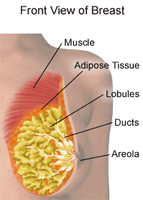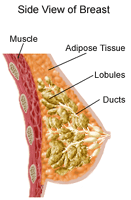Common Breast Lumps
What are some common types of noncancer (benign) breast lumps?
Two of the most common causes of noncancer (benign) single breast lumps are cysts and fibroadenomas. There are also several other conditions that can present themselves as lumps, such as fat necrosis and sclerosing adenosis.
What is a cyst?
A cyst is a fluid-filled sac that develops in the breast tissue and is most common in women nearing menopause. Cysts often enlarge and become sore and painful just before the menstrual period. They may seem to appear overnight. Cysts are rarely cancer (malignant) and may be caused by a blockage of breast glands.
Cysts can feel either soft or hard. When close to the surface of the breast, cysts can feel like a large blister—smooth on the outside, but fluid-filled on the inside. But when a cyst is deep within the breast tissue, it will feel like a hard lump because it is covered with tissue.
How are cysts diagnosed and treated?
Your healthcare provider may identify a lump as a cyst by physical exam. But many healthcare providers confirm the diagnosis by mammography or ultrasound exam. The provider may then perform a fine-needle aspiration as the next step in diagnosing the cyst. This procedure involves guiding a very thin needle into the cyst and drawing fluid from it. This procedure also serves as the treatment for this condition. That’s because once the fluid is removed, the cyst collapses and disappears. Cysts can reappear at a later date. If that happens, they are simply drained again.
What is a fibroadenoma?
Fibroadenomas are solid, smooth, firm, benign lumps. They are the most common benign lumps that occur in women. They can occur in women of any age. But they are most often found in women in their 20s and 30s. Increasingly, they are also being seen in postmenopausal women who are taking hormone therapy.
The painless lump feels rubbery, moves around freely, and very often is found by the woman herself. Fibroadenomas vary in size and can grow anywhere in the breast tissue.
How are fibroadenomas diagnosed and treated?
Most healthcare providers can recognize this type of lump simply by feeling it. But the diagnosis is confirmed by mammography or ultrasound and fine-needle aspiration. Sometimes, in very young women, the fibroadenoma is not removed. But sometimes these tumors enlarge with pregnancy and breastfeeding. So healthcare providers may recommend surgery to remove the fibroadenoma.
Most fibroadenomas don’t lead to cancer. But there is a type of fibroadenoma that has been linked to a slightly increased risk of cancer. This is particularly true for women with a family history of the disease.
What is fat necrosis?
Fat necrosis is a condition in which painless, round, firm lumps caused by damaged and disintegrating fatty tissues form in the breast tissue. Fat necrosis often occurs in women with very large breasts. Or it may happen after a bruise or blow to the breast. This condition may also be the result of a lumpectomy and radiation from a past cancer lump. In some cases, healthcare providers will watch the lump through several menstrual cycles. They may perform a mammogram before deciding whether or not to remove it. These lumps are not cancer. There is no reason to believe that they increase a woman's risk of cancer.
What is sclerosing adenosis?
Sclerosing adenosis is a breast condition that involves excessive tissue growth in the breast's lobules. This often causes breast pain. These changes in the breast tissue are microscopic. But they may show up on mammograms as calcifications and can produce lumps. Usually a biopsy is needed to be sure this is not cancer. In addition, because the condition can be mistaken for cancer, the lumps are usually removed through surgical biopsy. Some studies have found that women with sclerosing adenosis have a slightly increased risk of breast cancer.


Connect with us:
Download our App: